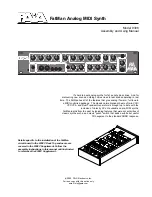
12
Low Frequency Oscillator -
Also called an
LFO,
this is a special type of voltage
controlled oscillator that oscillates primarily below the range of human hearing.
LFOs are typically used as a source of modulation.
For instance - an LFO with a triangle waveform at about 6 Hz modulating the pitch
of a VCO sounds like vibrato. The same LFO with a square wave will sound like a trill.
An LFO modulating a voltage controlled amplifier will sound like a tremolo (figure
10).
Sample and Hold -
This is a circuit with an input for a control voltage and an input
for a trigger. Each time the trigger is fired, the circuit takes the voltage that appears
at the input and holds it at the output until the next time the circuit is triggered.
An LFO is a common way to trigger a sample and hold (or S&H) circuit.
When an
LFO is applied to the trigger input, and a random signal such as white noise is
applied to the CV input, a random stepped voltage will appear at the output in
time with the each cycle of the LFO. (figure 11)
Glide
- Also called portamento, is the slowing down of pitch changes as you play
different notes on the keyboard. In synthesizers, a rate is specified that determines
how fast the glide between notes is.
These terms are basic to understanding analog subtractive synthesis. Should you
choose to pursue a more in depth study of the subject, recommended is the book
Analog Synthesis by Reinhard Smitz, available from Wizoo Publications
(www.wizoo.com).













































